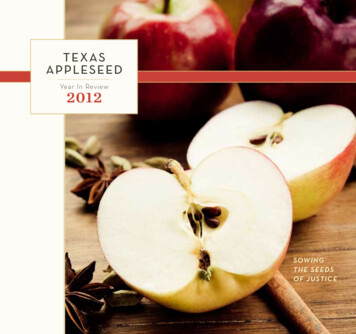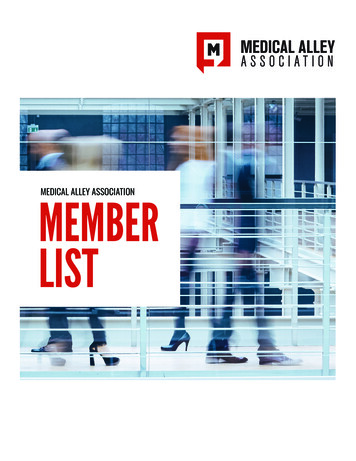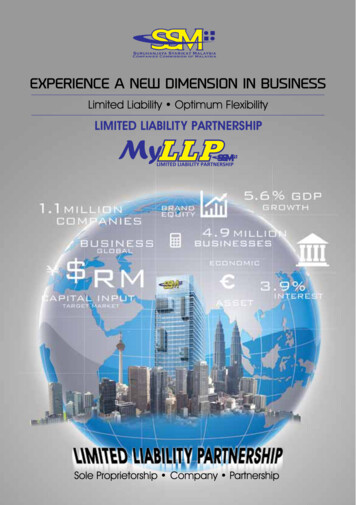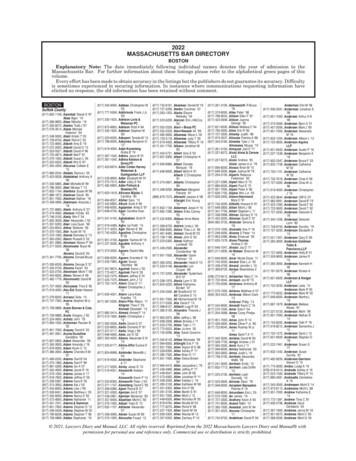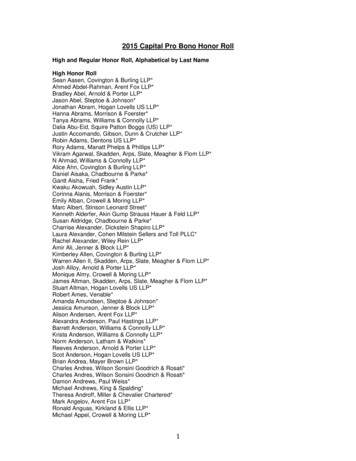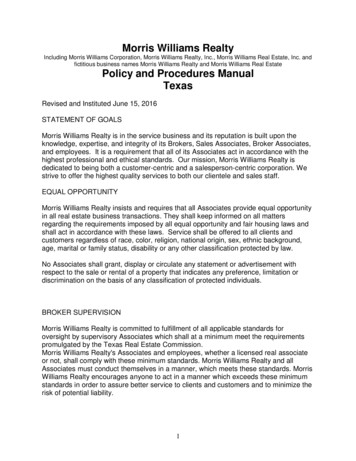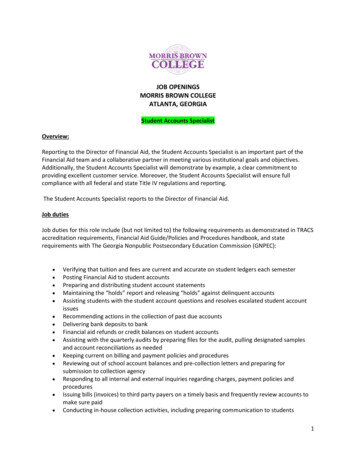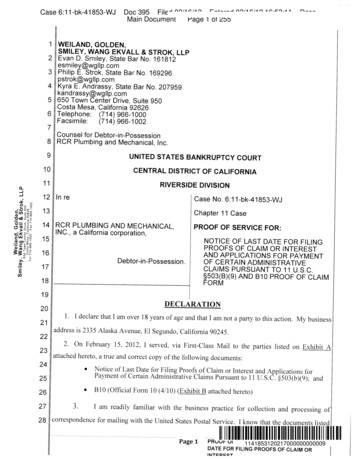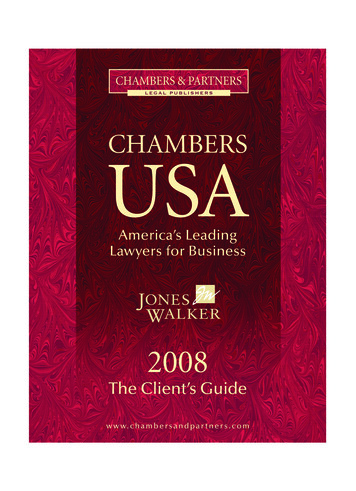
Transcription
GLOBAL PRACTICE GUIDEUKDefinitive global law guides offeringcomparative analysis from top ranked lawyerseDiscovery &DisclosureLAW AND PRACTICE:p.2Contributed by Walker Morris LLPThe ‘Law & Practice’ sections provide easily accessible information onnavigating the legal system when conducting business in the jurisdiction. Leading lawyers explain local law and practice at key transactionalstages and for crucial aspects of doing business.UKWalker Morris LLPchambers.com
UK Law and PracticeLaw and PracticeContributed by Walker Morris LLPContents1. Litigation Systemp.42. Electronically Stored Information (ESI)p.43. Case Law or Rules Relating to ESIp.44. Discovery/Disclosure of ESIp.65. Obligations to Preserve ESIp.96. Sanctions and Penaltiesp.107. Timing and Extent of Sanctionsp.108. Costs of Discovery/Disclosure of ESIp.119. Obligations of Parties to Meet and Conferp.1110. Scope of Party’s Obligation Regarding ElectronicDocumentsp.1111. Requirement to Certify that Search Carried Out p.1212. Form of Production of ESIp.1213. Advance Analytical Toolsp.1314. Production or Withholding Production ofPrivileged ESIp.1515. Privacy Statutes & Rules or Regulationsp.1516. Transfer of ESI Outside JurisdictionalBoundariesp.162
Law and Practice UKWalker Morris LLP handles a wide range of work for clientswith diverse business interests and requirements, including multi-million pound disputes. Core skills encompassUK and international litigation and arbitration, mediation,expert determination or other forms of alternative disputeresolution. Although based in Leeds, most of the firm’sUK-based litigation work is conducted through the courtsin London. The firm’s litigation department covers a broadrange of practice areas and types of work, from real estateand banking litigation, commercial contract disputes andemployment, through to construction and engineering, intellectual property and corporate and partnership disputes.The team’s eDisclosure work encompasses a wide variety ofcases across the board.AuthorsGwendoline Davies is a partner, head ofthe commercial litigation & disputeresolution team and a board member ofWalker Morris LLP. She has more than 30years of experience representing clients intheir most complex and importantdisputes. Her practice includes commercial litigationmatters, regulatory matters, internal investigations anddomestic and international arbitrations. Her broadexperience includes contractual disputes, shareholder andboardroom disputes, partnership disputes, project andjoint venture disputes, supply chain issues (includingproduct liability claims), business acquisition disputes,environmental disputes, fraud, tracing claims and disputesrelating to pensions. She regularly acts in cases requiringurgent remedies, such as applications for injunctions andspecific performance – for example, in relation toemployee fraud. Gwendoline is an accredited mediator anda fellow of the Chartered Institute of Arbitrators. She isalso a member of the International Bar Association andhas strong connections with law firms in the USA, Europeand Asia.Amanda Kent is a senior associateprofessional support lawyer for the firm’slitigation department, supporting thecommercial dispute resolution, regulatory& compliance, construction & engineeringand finance litigation teams. In this roleAmanda is responsible for keeping the department and thefirm’s clients abreast of new litigation legal developments,including in relation to eDisclosure, through legal insights,articles and training. Prior to joining Walker Morris LLP,Amanda worked as a solicitor and senior associate in thelitigation & regulatory group of a global law firm, whereshe specialised in all forms of commercial disputeresolution (including arbitration) with an emphasis ongeneral commercial and business disputes, insurance/reinsurance claims and coverage issues, both domestic andcross-border. Amanda’s experience involved dealing withlitigation at all levels of the English court system andincluded complex eDisclosure management.Marie-Louise Gregory has over 13 years’post-qualification experience as acommercial litigation solicitor, withsignificant expertise of a broad range oflegal disputes. Originally specialised inreal estate litigation, more recentlyMarie-Louise has become a senior associate professionalsupport lawyer for Walker Morris’ litigation department,providing expert legal and procedural support for thecommercial dispute resolution, real estate litigation andbanking litigation teams. In this role she is responsible formeeting the department’s know-how requirements andkeeping the teams and the firm’s clients abreast of newdevelopments in the litigation and dispute resolution arena– including eDisclosure – through legal insights, case andpractice notes, articles and training.3
UK Law and Practice1. Litigation System3. Case Law or Rules Relating to ESIThe civil litigation system within the jurisdiction of Englandand Wales is a common law, adversarial system where thedefault method of resolving disputes is via the High Court(or the County Court for smaller value claims). The HighCourt is divided into three parts (the Chancery Division,the Queen’s Bench Division and the Family Division) andhas a number of specialist courts, many of which, as from4 July 2017, fall within the umbrella jurisdiction of the new‘Business and Property Courts’. The Business and PropertyCourts encompass the Commercial Court, the AdmiraltyCourt, the Circuit Commercial Courts (formerly the Mercantile Court), the Technology and Construction Court(TCC) and the courts of the Chancery Division, includingthose dealing with financial services, intellectual property,competition and insolvency.Over the last decade or so, with the exponential growth inthe use of electronic devices, a body of procedural rules andcase law relating specifically to the disclosure of ESI (knownin England and Wales as edisclosure) has come into being.The litigation process is governed by the Civil ProcedureRules (CPR), and there are various specific guides that applyto the conduct of litigation in particular divisions or specialist courts. There is an appellate system, whereby a decisionof the High Court can be appealed to the Court of Appealand ultimately to the Supreme Court of the United Kingdom,and the decisions of the higher courts are authoritative andbinding on the lower courts. The civil litigation system ofEngland and Wales is therefore multi-tiered, but it is nota dual court system (federal/local), as in the United States,for example.2. Electronically Stored Information(ESI)The law relating to disclosure of documents (including ESI)derives from both the CPR (and any applicable court guide)and case law. It is subject to continual review and development. The law of disclosure considered in this document isthat which applies in respect of larger, ‘multi-track’ cases.(Simplified rules set out in the CPR apply for smaller cases,and are outside the scope of this document.)A ‘document’ for the purposes of disclosure means anything that records information of any description. It is avery wide definition, including not only hard copy, paperrecords such as contracts, diaries, reports, notes and letters but also electronic documents (or edocuments) such astexts, blogs, tweets, posts and all related metadata, includingtemporary files, data that might have been deleted, and allother ESI. Where the terms ‘document’ and ‘disclosure’ areused within this document, they include edocuments/ESIand edisclosure respectively. It is worth noting that, wherea copy document contains annotations or amendments notshown on the original, the copy is itself a separate documentfor these purposes.4The main edisclosure rules are contained within the following: CPR 31 and Practice Directions (PD) 31A and 31B,including the electronic documents questionnaire (EDQ)which is annexed to PD 31B and available in court formN264; privacy-related legislation, which can affect whether andhow documents are collected, reviewed or disclosed (see15 Privacy Statutes & Rules or Regulations, below); and case law.A two-year mandatory disclosure pilot scheme came intooperation in the Business and Property Courts acrossEngland and Wales on 1 January 2019. The pilot schemeencompasses new procedural rules, set out in CPR PracticeDirection 51U, which are designed to facilitate a new, moreco-operative, proportionate and efficient approach to disclosure (which has, historically, been a cost-heavy part ofthe litigation process). A detailed summary of the disclosurepilot scheme is set out in 4 Discovery/Disclosure of ESI,below.The following key cases have been instrumental in shapingCPR 31 and PD 31A and 31B, and comprise authoritativeand practical guidance for practitioners and for the courtson how to approach edisclosure in any given case.Digicel (St Lucia) Ltd & Ors v Cable & Wireless plc &Ors[2008] EWHC 2522 (Ch)This case decided that edisclosure can extend to the restoration and search of back-up tapes. It also confirmed that proportionality is to be taken into account when additional keyword searches are requested, and that parties should meetearly in a case to discuss edisclosure issues, including seekingto agree keywords. Proportionality was also relevant to thequestion of whether the back-up tapes should be restoredand searched. These principles have effectively been incorporated into the CPR (in particular CPR 1 and 31 and PD31A and 31B), although the procedural rules go somewhatfurther, and so the law is now more prescriptive than it waswhen this important case was decided.(CPR 1 requires the court and both parties to give effect tothe ‘overriding objective’ of dealing with cases ‘justly andat proportionate cost’. As part of widespread proceduralreforms to the CPR introduced in April 2013, the additionof the words ‘and at proportionate cost’ embodied the courts’new emphasis – when it comes to disclosure and all other
Law and Practice UKaspects of case management and procedure in civil litigationin England and Wales – on proportionality of cost, bearingin mind factors such as the amount or value of any moneyor property involved, the importance of the matter to all theparties, the particular complexity of the matter, and so on.See also CPR 44.)Earles v Barclays Bank plc [2009] EWHC 2500 (Mercantile)This case confirmed that anyone practising civil litigationin England and Wales without being aware of and practising the rules on edisclosure is guilty of ‘gross incompetence’.The case therefore serves as a salutary warning to litigationlawyers that they risk being guilty of professional negligenceif they do not know and properly follow edisclosure rules.Gavin Goodale & Ors v Ministry of Justice & Ors [2009]EWHC B41 (QB)This was the first known case in which the parties wererequired by the court to complete what was then a draftform of the EDQ, which now forms part of the CPR (seethe schedule to PD 31B). The case also contains a usefulreminder of the general approach to edisclosure that shouldbe adopted, including emphasising the importance of the‘staged’ approach to considering edisclosure, which is nowcodified in PD 31B.9 (3) (g), PD 31B.23 and CPR 31.5 (8)(that is, with disclosure initially being given of limited categories of documents and those categories potentially beingsubsequently extended or limited, depending on the initialresults).West African Gas Pipeline Co Ltd v Willbros GlobalHoldings Inc. [2012] EWHC 396 (TCC)In this case, the court imposed costs penalties for edisclosurefailures and highlighted the importance of parties assembling a consistent and complete set of disclosure documents(specifically including ESI) with no duplication, and of enabling a proper review. Compliance with the EDQ now assistsgreatly with that process.Mueller Europe Ltd v Central Roofing (South Wales) Ltd[2012] EWHC 3417 (TCC) and CBS Butler Ltd v Brown& Ors [2013] EWHC 3944 (QB)These are two seemingly contrasting High Court decisionsregarding whether or not the edisclosure exercise should becarried out by a specialist external IT consultant. In fact, inany given case, the answer will depend on how best the overriding objective is served. A significant factor will, of course,be proportionality in terms of the cost of the edisclosureconsultant’s involvement as against the value of the case.Smailes & Anor v McNally & Anor [2015] EWHC 1755(Ch)This case highlighted a particularly important practicalquality control issue. The low quality of optical characterrecognition (OCR) copies of scanned documents broughtinto doubt whether searches had identified all or most ofthe keyword-responsive documents. In this particular case,that led to a breach of the disclosure order and emphasisedto parties and practitioners alike the need to ensure sufficientquality control when it comes to edisclosure, so that the process does not become vulnerable to criticism, as criticism ofa party’s searches/disclosure can lead to the process havingto be repeated, resulting in significant wasted time and cost.Pyrrho Investments Ltd & Anor v MWB Property Ltd &Ors [2016] EWHC 256 (Ch) and Brown v BCA TradingLtd [2016] EWHC 1464 (Ch)These cases concerned the use of predictive coding, a formof technology assisted review (TAR), which is where, in itssimplest form, a sample data set is reviewed by (probablysenior) lawyers acting on the case and coded, with that coding then effectively being applied by specialist technologyto review the remaining documents. Pyrrho was the firstreported case in the courts of England and Wales to approvethe use of predictive coding, and acknowledged that it can beparticularly useful as it can improve consistency within thedisclosure/review exercise and can be at least as accurate as amanual review. In Brown v BCA, the court went so far as toorder the use of predictive coding despite a party’s objection.Whilst the courts have been careful to make clear that whether predictive coding is appropriate in a case will depend onthe individual circumstances, taking into account proportionality, efficacy and suitability, it seems clear that, in today’stechnology-driven world, the use of TAR in various formswill become increasingly prevalent.National Bank of Abu Dhabi PJSC v BP Oil International Ltd [2016] EWHC 2892 (Comm)The Business and Property Courts, in appropriate cases, nowoffer the Shorter and Flexible Trials schemes, under whichkey elements of the civil litigation process are shortened,tailored or even dispensed with altogether, in order that trials can be heard and judgments delivered earlier and at lesscost than would otherwise be possible. The recent case ofNational Bank of Abu Dhabi PJSC v BP Oil InternationalLtd [2016] EWHC 2892 (Comm) was the first trial to takeplace under the Shorter Trials scheme. The case is particularly interesting because it was fully resolved within just afew months from commencement of the claim and followinga trial of just one day, despite the claim being worth overUSD68 million. The case covered the correct interpretationof just two contract documents. The parties agreed that thecase could suitably be dealt with under the Shorter Trialsscheme, witness evidence was dispensed with and, crucially, there was very limited disclosure. The court praised theparties for this co-operative and commercial approach, andthe costs incurred by each party amounted to significantlyless than if the case had been fought under traditional rules(where the disclosure exercise can often be one of the mostcostly and time-consuming stages). This case demonstrates5
UK Law and Practicethat the need for extensive disclosure does not necessarilycorrelate with the value of a claim.Aircraft Purchase Fleet Ltd v Compagnia Aerea ItalianaSPA (2017, unreported)In this case, a high-value contractual dispute arose betweenthe parties and the matter was listed for a three-week trial.The defendant sought disclosure of documents from 2008 to2013 concerning the claimant’s alleged breach of contract.Although all of the documents sought by the defendantwere potentially relevant, the court decided that it was actually appropriate, by reason of proportionality (and despitethe substantial value of the claim), to restrict disclosure toedocuments from just 2011, and to those arising from a listof no more than five agreed search terms.Apart from the CPR and the cases discussed above, various legal bodies have issued a number of reports, guidelinesand protocols that are helping to shape the development ofedisclosure procedure in England and Wales. Whilst suchguidance is not necessarily authoritative and binding, it maybe taken into account by the courts, especially where it canassist by demonstrating potential options for resolving edisclosure issues. For example, the Technology and Construction Court Solicitors’ Association (TeCSA), the Technologyand Construction Bar Association (TECBAR) and the Society of Computers and the Law (SCL) produced an edisclosure pack, including an edisclosure protocol and guidelines,all of which have informed the approach of parties and thecourts to edisclosure since their publication in 2013. In fact,the protocol has been adopted by the TCC to the extent thatit is now referred to in the TCC Guide and has applied tocases in the TCC since 1 January 2014.4. Discovery/Disclosure of ESIThe courts of England and Wales are increasingly placinga significant emphasis on alternative dispute resolution(ADR), which encompasses a range of dispute resolutionoptions available over and above litigation/court proceedings, including negotiation, mediation, arbitration, expertdetermination, and others. Accordingly, ADR is encouragedby various means, one of which is that the CPR contain anumber of protocols (compliance with which is enforcedvia case management and costs sanctions) specifying thepre-action conduct required of parties. In many instances,complying with pre-action protocols and engaging in meaningful ADR attempts will involve the parties agreeing toexchange key evidence and documents – a process which,in practice, can be tantamount to disclosure.Consistent with the drive to resolve disputes without the parties incurring the time and cost of litigation where possible,the CPR also allow parties to apply to the court for an orderthat documents which would be disclosable if proceedings6were on foot should be disclosed pre-action, if that would bedesirable to dispose fairly of the anticipated proceedings, toassist in the resolution of the dispute without court proceedings, or otherwise to save costs. Making an application forpre-action disclosure can be a helpful and efficient tacticalstep in appropriate cases.In some circumstances, the CPR and case law provide thatthe courts may make orders for disclosure against personswho are not (and are not likely to be) a party to court proceedings. Such orders can be made prior to or alongsideactive court proceedings. For example, CPR 31.17 allows disclosure against non-parties where the documents sought arenecessary to deal with the claim fairly or to save costs, andissuing a witness summons under CPR 34.2 can compel awitness to produce documents. A Norwich Pharmacal order(named for the case that established jurisdiction for this typeof order) can be granted against a person who will not beparty to subsequent proceedings so as to identify anotherperson (for example, a wrongdoer or a potential beneficiary)or to identify the nature of a wrongdoing, who or which willbe the subject of subsequent proceedings. However, NorwichPharmacal orders involve an invasion of privacy and placea burden on the receiver, who may have become involvedinadvertently and innocently; they must therefore not beused as a ‘fishing expedition’, and are an equitable remedy,which means they are issued entirely at the court’s discretion.Another example of a disclosure order made against a nonparty is a Chabra order (again, named for the case thatestablished the jurisdiction) whereby the court may orderdisclosure of documents, ancillary to a freezing order madeagainst a non-party who appears to hold assets on behalf ofthe defendant. Finally, a bank may be ordered to disclosedocuments relating to the account of a customer who hasbeen guilty of fraud, to enable a claimant to trace its assets.In terms of formal disclosure once court proceedings arein process, as soon as a defence to a claim is filed, the courtwill serve a notice on the parties requiring them to complete and file a directions questionnaire, and will set a datefor a costs and case management conference (CCMC). Thelegal and practical issues of dealing with disclosure must beconsidered by the parties at this early stage. The directionsquestionnaire asks for certain information relating to ESI inparticular, and the parties are required to discuss and seekto agree an appropriate approach to disclosure (and ideallyto agree directions in that regard) and to file their proposeddraft directions for the case management of the proceedings along with the questionnaire. CPR 31.5 (5) requiresthat the parties must, no less than seven days before the firstCCMC discuss and seek to agree a proposal in relation todisclosure that meets the overriding objective, at a meeting or by telephone. PD 31B.8 and 31B.9 impose mandatory requirements for communications between the partiesbefore the first CCMC in relation to the use of technology
Law and Practice UKin the management of ESI and in relation to the disclosureof edocuments.As mentioned briefly in 3 Case Law or Rules Relating toESI,above, the EDQ is annexed to PD 31B and this specifically helps parties to address practical and technical issuesrelating to ESI. Completion of the EDQ (which may be voluntary or may be ordered by the court – see below) deals insome detail with the following: the extent of a reasonable search for ESI (includingconsideration of appropriate date ranges, the custodiansof ESI and what different types of ESI are likely to beinvolved in the case); different search methods (including keyword searchesand other types of automated/TAR searches); preservation of ESI; and accessibility/compatibility of ESI.Completion of the ESI section of the directions questionnaire and the EDQ will, in most cases, require input fromparties themselves, and probably their IT specialists and/ordocument management/edisclosure consultants, as well aslegal representatives.No fewer than 14 days before the CCMC, the parties are alsorequired to file a Disclosure Report, which provides an outline of their proposed approach to disclosure. The DisclosureReport describes what documents exist or may exist that areor may be relevant; where or with whom they are or may belocated; where edocuments are stored; an estimate of thecosts involved in giving standard disclosure (including thecosts of searching for and disclosing any edocuments); andwhich disclosure orders will be sought at the CCMC. TheDisclosure Report must be signed with a statement of truth.Contempt of court proceedings may be brought against aperson if he makes, or causes to be made, a false statementin a document verified by a statement of truth without anhonest belief in its truth.At the CCMC, the judge will make an order that sets outthe case management directions, effectively a timetable ofthe steps that must be undertaken to take the case to trial.Included within that will be an order for disclosure, whichwill impose the continuing duty of disclosure and definethe scope of the duty with which the parties must comply.In cases involving significant ESI, the disclosure order mayrequire the parties to complete the EDQ, if they have notdone so already. Where it is exchanged between the parties,the EDQ must be signed with a statement of truth.The disclosure order will generally specify the times bywhich each party must complete its searches for all disclosable documents and give disclosure by serving its Listof Documents (Form N265) on the other party or parties.The List identifies all documents that are disclosable, andindicates which of them the party claims to be entitled towithhold from inspection, either because they are privileged(see below for further explanation) or because they are nolonger within the party’s custody, possession or control. TheList includes a disclosure statement that explains the extentof the searches undertaken. Contempt of court proceedingsmay be brought against a person who makes, or causes to bemade, a false disclosure statement without an honest beliefin its truth.The disclosure order usually also specifies the time forinspection of disclosed documents (if it does not, CPR 31.15contains default provisions on the timing for inspection).Inspection usually takes place by exchange of photocopiesof documents, by inspection of originals at a pre-arrangedtime and location, and/or by electronic exchange, in the caseof ESI specifically. Practical and technical details concerningelectronic exchange should have been discussed by the parties prior to the CCMC and/or addressed in the EDQ. UnderCPR 31.14, a party may inspect a document that has beenreferred to in a statement of case (for example, the particulars of claim or defence) and certain other documents in theproceedings, such as witness statements.Where a party suspects that another has not provided fulldisclosure, it is possible for that party to make an applicationto the court for specific disclosure of the suspected missingitem[s], pursuant to CPR 31.12.Disclosure Pilot SchemeAs mentioned in 3.1 Case Law or Rules Relating to ESI,above, a two-year mandatory disclosure pilot scheme cameinto operation in the Business and Property Courts acrossEngland and Wales on 1 January 2019. This pilot scheme,set out in CPR PD 51U, is designed to facilitate a new, moreco-operative, proportionate and efficient approach to disclosure.Under the pilot scheme, the usual menu of disclosureoptions is replaced by initial disclosure of key documentswith the parties’ statements of case and, where appropriate,extended disclosure comprising a new list of ‘models’, ranging from disclosure of known adverse documents only, towide search-based train of enquiry disclosure. Importantly,there is no automatic entitlement to search-based disclosure in the pilot scheme, or indeed to any form of extendeddisclosure, and the Disclosure Working Group is clear thatthe court should not accept without question the disclosuremodel proposed by the parties. The court may also orderextended disclosure using different models for differentissues for disclosure in the case.Another key feature of the pilot scheme is that it expresslysets out more onerous and prescriptive duties for parties andtheir legal representatives than those contained in CPR Part31 and PDs 31A and 31B. (The duties are set out at para-7
UK Law and Practicegraphs 2 to 4 inclusive of PD 51U.) For example, the duty inrelation to the preservation of documents includes obligations to: suspend relevant document deletion or destructionprocesses for the duration of the proceedings; send a writtennotification to all relevant employees and former employeeswhich identifies the documents or classes of documents tobe preserved and notifies the recipient that they should notdelete or destroy those documents and should take reasonable steps to preserve them; and take reasonable steps sothat agents or third parties who may hold documents on theparty’s behalf do not delete or destroy documents that maybe relevant to an issue in the proceedings. Each party mustconfirm in writing when serving their particulars of claim/defence that steps have been taken to preserve potentiallyrelevant documents in accordance with the client’s/legal representative’s duties of preservation. Regardless of any orderfor disclosure made, the parties are under a duty to discloseknown adverse documents, unless they are privileged.If/when an order for extended disclosure is made (and following any initial disclosure), one of the steps involved incomplying is the provision of a Disclosure Certificate (in theform set out in Appendix 4 to PD 51U). As part of that, theparty giving disclosure is required to certify that it is awareof, and to the best of its knowledge and belief has compliedwith, its duties. There is a note at the end of the certificatewhich explains that, if the party making disclosure is a company or other organisation, the person signing the certificateshould be “someone from within the organisation with appropriate authority and knowledge of the disclosure exercise,” andthat they will have “received confirmation from all those people with accountability or responsibility within the companyor organisation either for the events or circumstances whichare the subject of the case or for the conduct of the litigation,including those who have since left the company or organisation, that they have provided for disclosure all adverse documents of which they are aware.” The role of the person signingis then specified, with an explanation as to why he or she isthe appropriate signatory. Proceedings for contempt of courtcan be brought for signing a false Disclosure Certificate.The procedure under the pilot scheme is, in short:Initial DisclosureWhen serving their particulars of claim or defence, partiesare required to give Initial Disclosure of key documentsrelied on by the disclosing party in support of the claimsor defences advanced in its statement of case and key documents necessary for other parties to understand the claim ordefence they have to meet. This obligation could however bedispensed with by agreement, or by the court, and it wouldnot apply where a party concluded that it would involve anyparty providing more than 1000 pages or 200 documents(whichever is larger).8Extended DisclosureWithin 28 days of the final statement of case each partyshould state, in writing, whether or not it is likely to requestExtended Disclosure (apart from under Model A – seebelow) o
eDiscovery & Disclosure . UK Law and Practice 2 Law and Practice Contributed by Walker Morris LLP contents 1. Litigation System p.4 2. electronically Stored information (eSi) p.4 3. case Law or rules relating to eSi p.4 4. discovery/disclosure of eSi p.6 5. Obligations to Preserve eSi p.9 6. Sanctions and Penalties p.10
